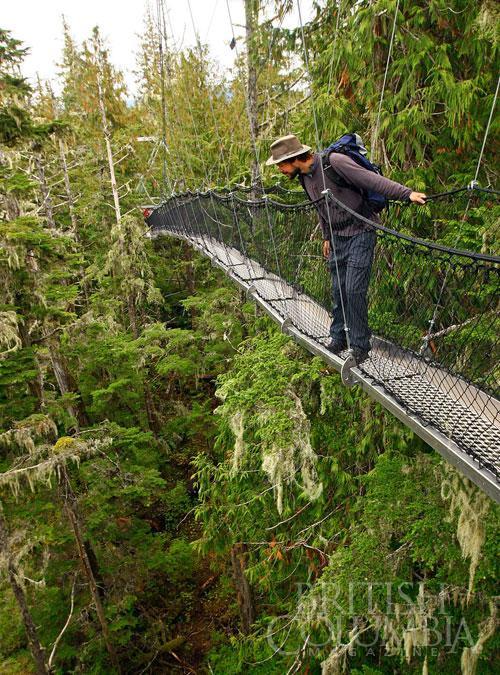Please note that the Metlakatla Wilderness Trail has been closed and will remain closed for the 2019 season.
The biggest challenge on this coastal route is turning back for home.

The ferry rocks me back to sleep as I lean against my fiancé, Nick Hosgood, and watch Digby Island pass by. We met our group at 8 a.m. on the Prince Rupert docks and, after an orientation from original trail project coordinator Cory Stephens that included warnings about bears, tree-climbing porcupines, stray dogs, and swaying suspension bridges, we embarked on the 15-minute trip through Venn Passage to Metlakatla.
Last year, the Metlakatla First Nation, a Tsimshian community, opened its backyard to visitors when it completed the 10-kilometre Metlakatla Wilderness Trail. It seemed like the perfect place to unwind after a busy summer.
Once ashore, we lengthen our strides, leaving behind a dozen or so hikers—both locals and travellers from Europe and Asia. In Metlakatla (population roughly 80), we pass faded houses that overlook the Pacific Ocean. As we descend into cedars at the edge of town, two balls of white fur yip at our ankles—not exactly the feral creatures I’d pictured.
The trail starts out by following boardwalks and capped gravel pathways. Within the first two kilometres we encounter two suspension bridges, a beachside picnic site, and two viewing towers. Visitors could easily amuse themselves for a day here.
But we push on. Beaches beckon as the trail follows their arc before curving back into dense hemlocks. After six kilometres, the low-grade gravel trail gives way to springy moss and begins a gentle undulation. It feels as if few have walked this way—at least, in recent years. This area has been inhabited for thousands of years by the Coast Tsimshian. Culturally modified trees and shell middens are the remnants of abandoned villages, some up to 5,000 years old.
The sun is burning through morning cloud when, after seven kilometres, we find ourselves alone on the final suspension bridge. Halfway across Nick turns with a grin and offers a wobbly kiss. Just then I feel something soft brush my leg: something fluffy with a wet nose.
The dogs have followed an athletic-looking trio, who somehow beat us to the campsite located at 7.5 kilometres, just beyond the bridge. “How are you making out?” the man greets me cheerfully. I grimace.
Nestled beneath towering cedars next to the beach, the trail’s only campsite (not yet open) is an inviting place to hang a hammock and stay awhile. We spread our lunch out on a driftwood log overlooking Hecate Strait.
According to Stephens, the most beautiful beaches line the trail’s final two kilometres. There are tentative plans to connect the existing route with Lax Kw’alaams (Port Simpson), 30 kilometres to the north.
But today, we need to cut our hike short to catch the 4 p.m. ferry. Turning back might, in fact, present Metlakatla Wilderness Trail’s biggest challenge. We reluctantly follow the trio, meandering onto beaches and zigzagging over exposed seaweed beds. Finally, we climb up one of the 15-metre viewing towers and find ourselves blissfully alone—then we sprint for the ferry back to Prince Rupert.
Getting there
Access Prince Rupert via Highway 16, 140 kilometres west of Terrace; from Port Hardy, it’s a 15-hour ferry ride. There are also flights into Prince Rupert.
Info
There is a $25 per person fee to hike the trail, plus $12 for the ferry. (Inquire about discounts for students, children, families, seniors, and locals.) Bookings must be made in advance. Visit metlakatlatrail.ca or call 250-624-1822 to book and for ferry schedules. The trail is open May 1 to October 1.

